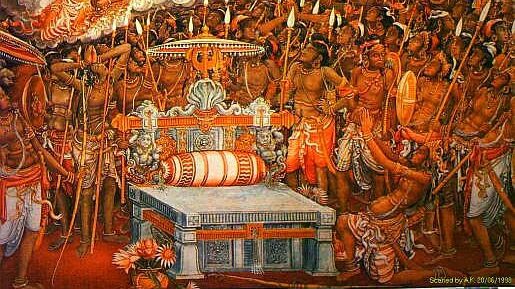BAK POYA DAY
Bak Pura Pasaloswaka Poya Day commemorates the second visit of The Buddha to Sri Lanka which took place in the fifth year of his Supreme Enlightenment.
According to the Mahavamsa, the Buddha visited Nagadipa as he wanted to put an end to the feud between two groups belonging to the Naga community and bring peace to the land.
One group was headed by King Mahodara, ruler of the Naga Kingdom. King Mahodara’s sister’s son was the leader of the opposing party. His name was Chulodara. It was a war between uncle and nephew, and they were fighting over a gem-studded throne Manipalaga, which had been given to Chulodara’s mother by her father.
The Buddha hovered in mid-air above them by His divine power when the two warring parties were in battlefield.
 The Buddha shrouded the entire area in darkness, then bathed it in a bright light. When members of the Naga tribe witnessed this miraculous act, they were overjoyed and worshipped the Buddha. Then he preached his message to the crowd relating several Jataka Katha. They were the Kakoluka, Phandana, Latuka, and Wattaka Jataka Stories. In this way he was able to bring about harmony amongst the Naga people.
The Buddha shrouded the entire area in darkness, then bathed it in a bright light. When members of the Naga tribe witnessed this miraculous act, they were overjoyed and worshipped the Buddha. Then he preached his message to the crowd relating several Jataka Katha. They were the Kakoluka, Phandana, Latuka, and Wattaka Jataka Stories. In this way he was able to bring about harmony amongst the Naga people.
This historic event took place on the island of Nagadeepa or Nainathivu (நயினாதீவு) which is off the Jaffna coast in the northern province of Sri Lanka. At the very site where the Buddha preached his message of peace now stands the Nagadeepa Purana Rajamaha Viharaya.
The two warring Kings had offered the gem-studded throne to the Buddha after the feud was settled, as a token of their gratitude. The Buddha however, had courteously declined this gift. Thereafter, the Rajayathana Stupa, according to Buddhist history, was constructed with the throne enshrined within.
 It was on a Bak Poya Day Prince Siddhartha saw four sights: a man bent with old age, a person afflicted with sickness, a corpse, and a wandering ascetic. It was the fourth sight, that of a wandering ascetic, that filled Siddhartha with a sense of urgency to find out what lay at the root of human suffering.
It was on a Bak Poya Day Prince Siddhartha saw four sights: a man bent with old age, a person afflicted with sickness, a corpse, and a wandering ascetic. It was the fourth sight, that of a wandering ascetic, that filled Siddhartha with a sense of urgency to find out what lay at the root of human suffering.


